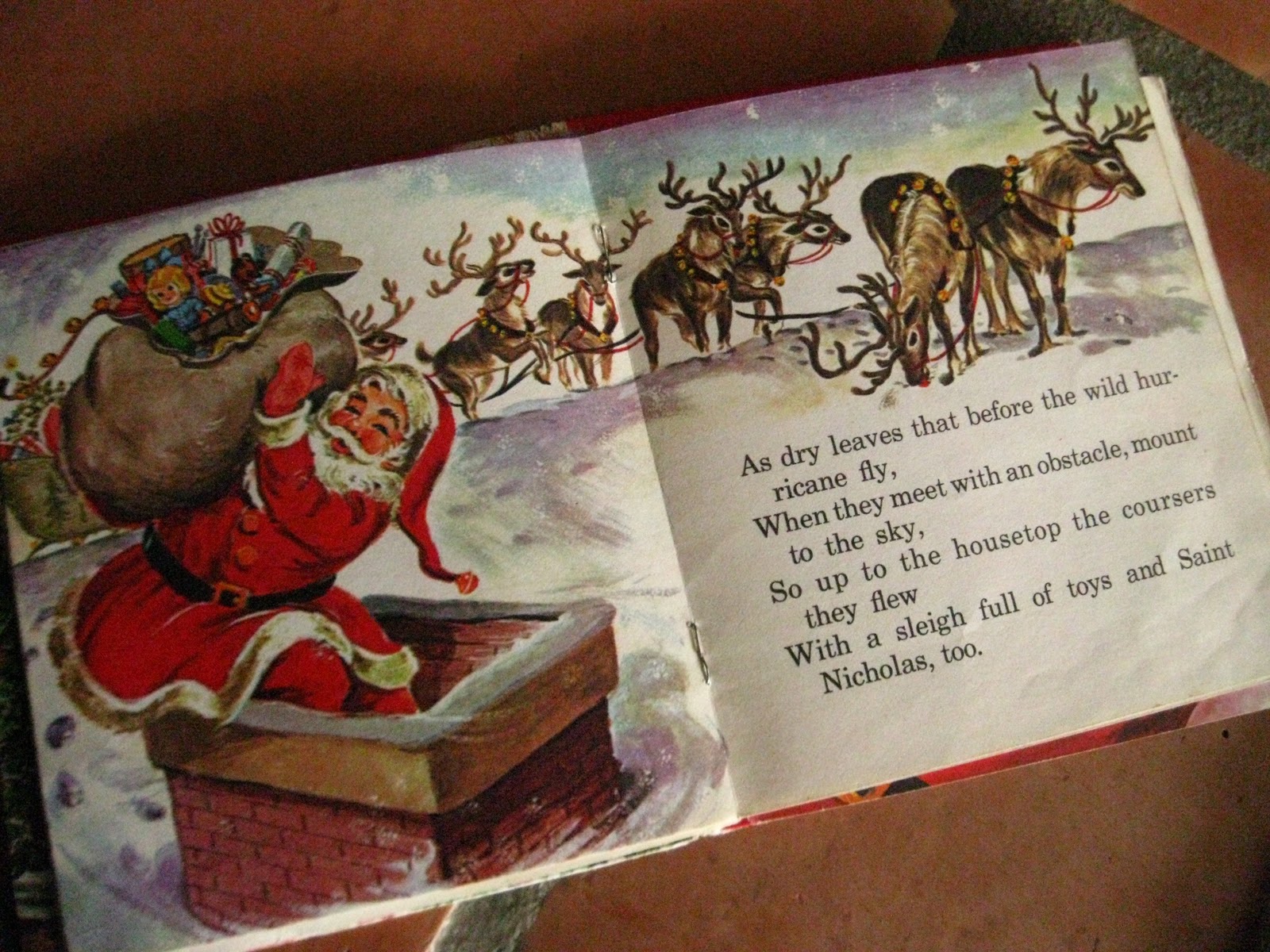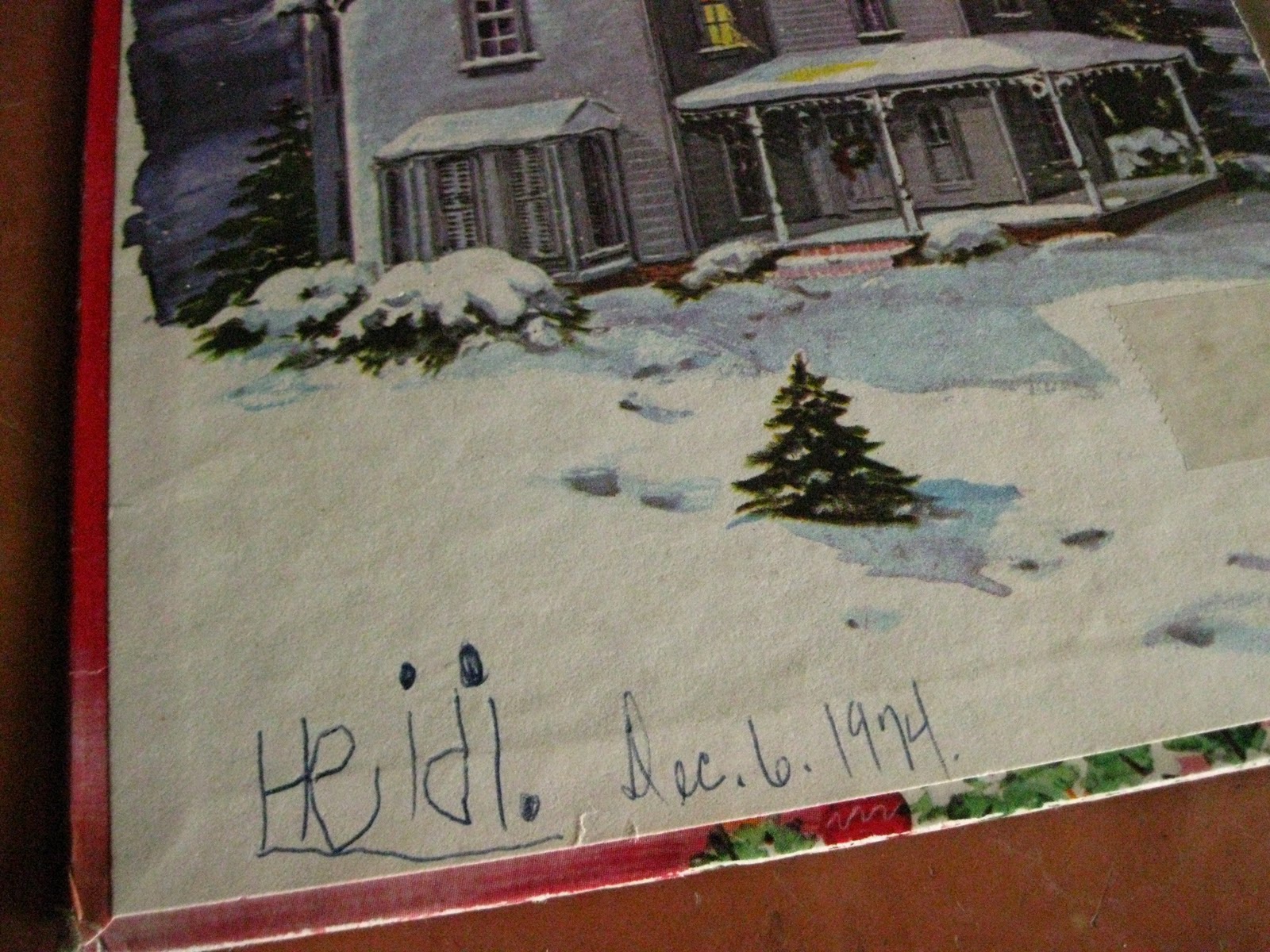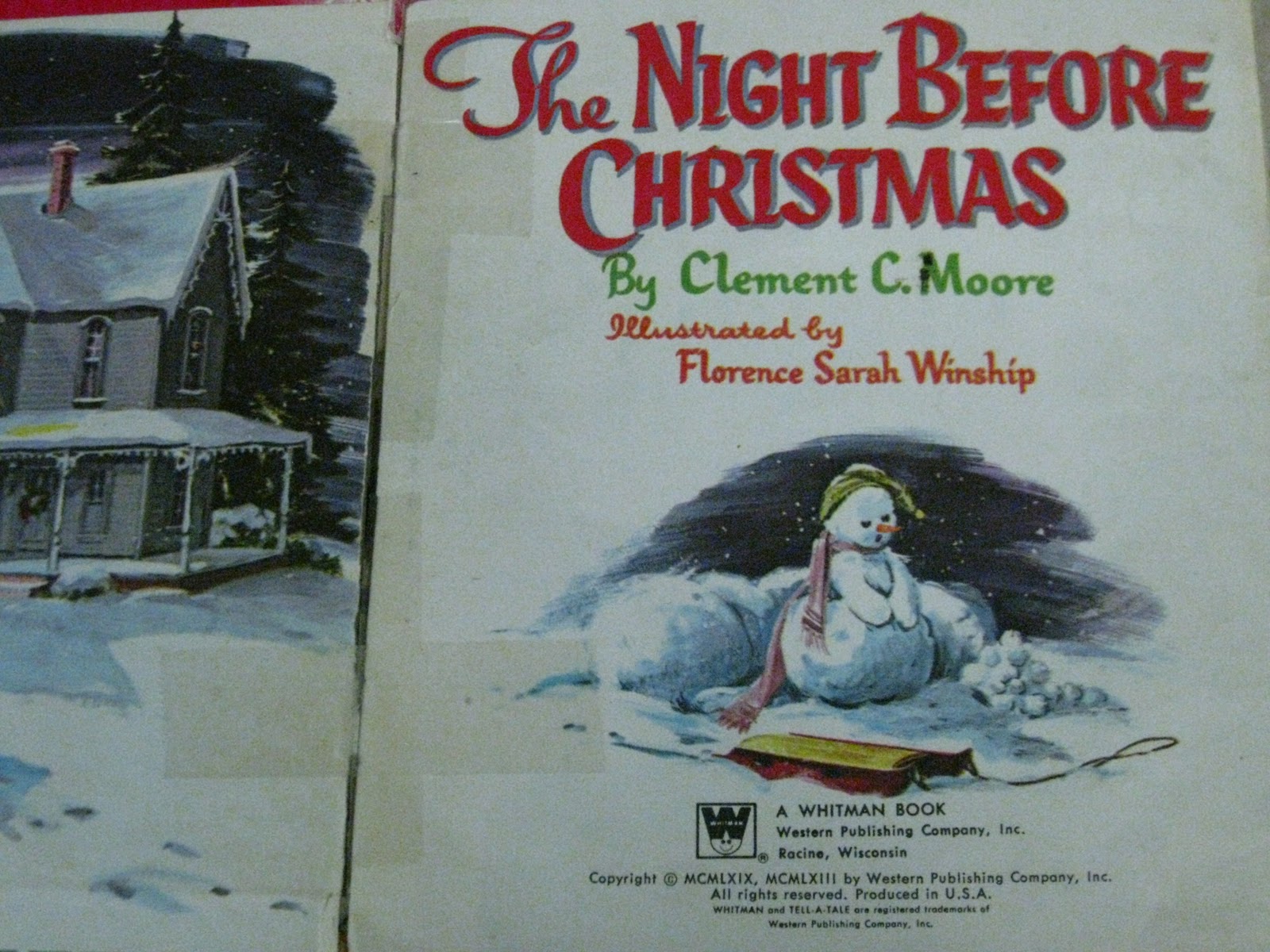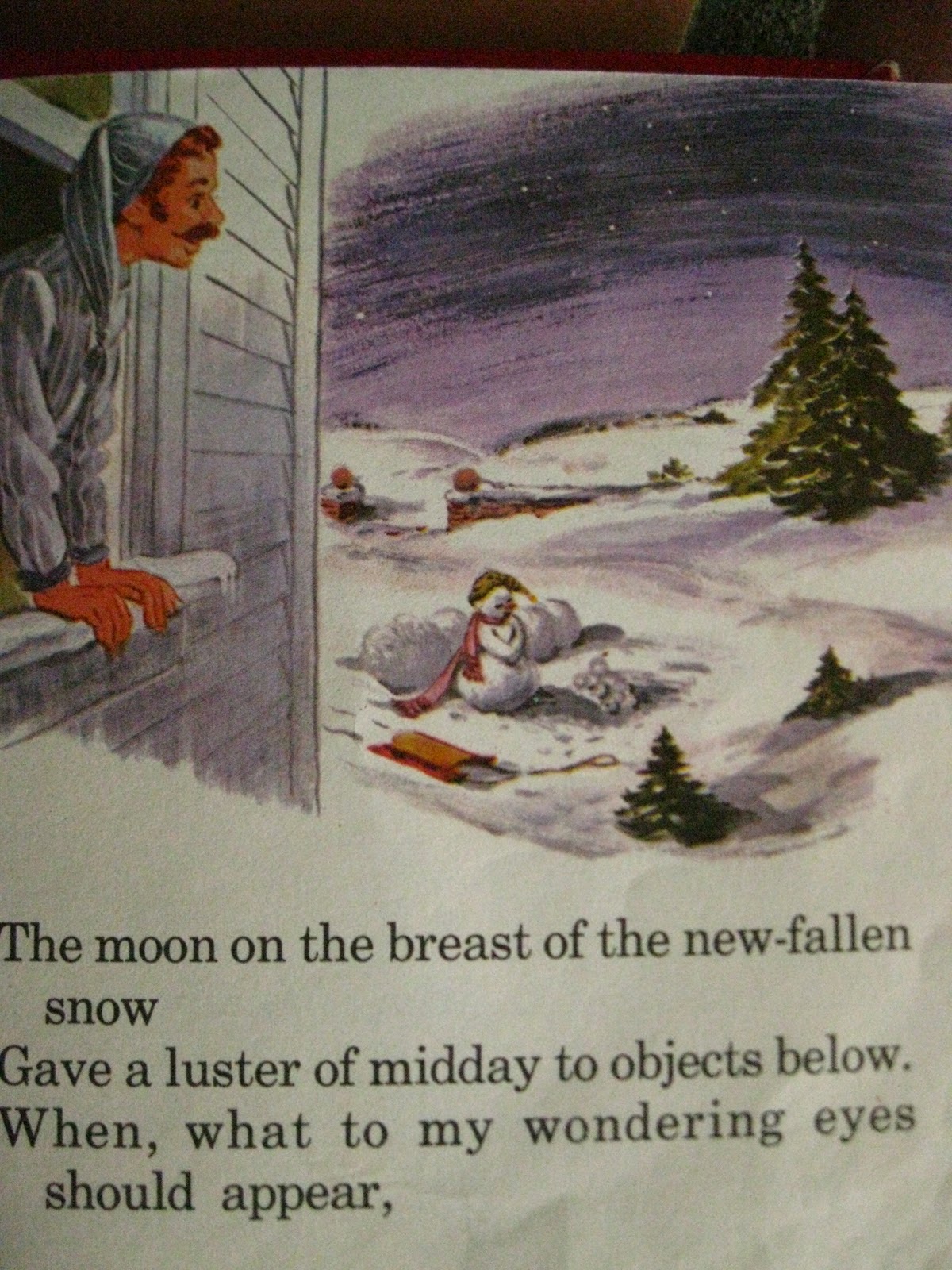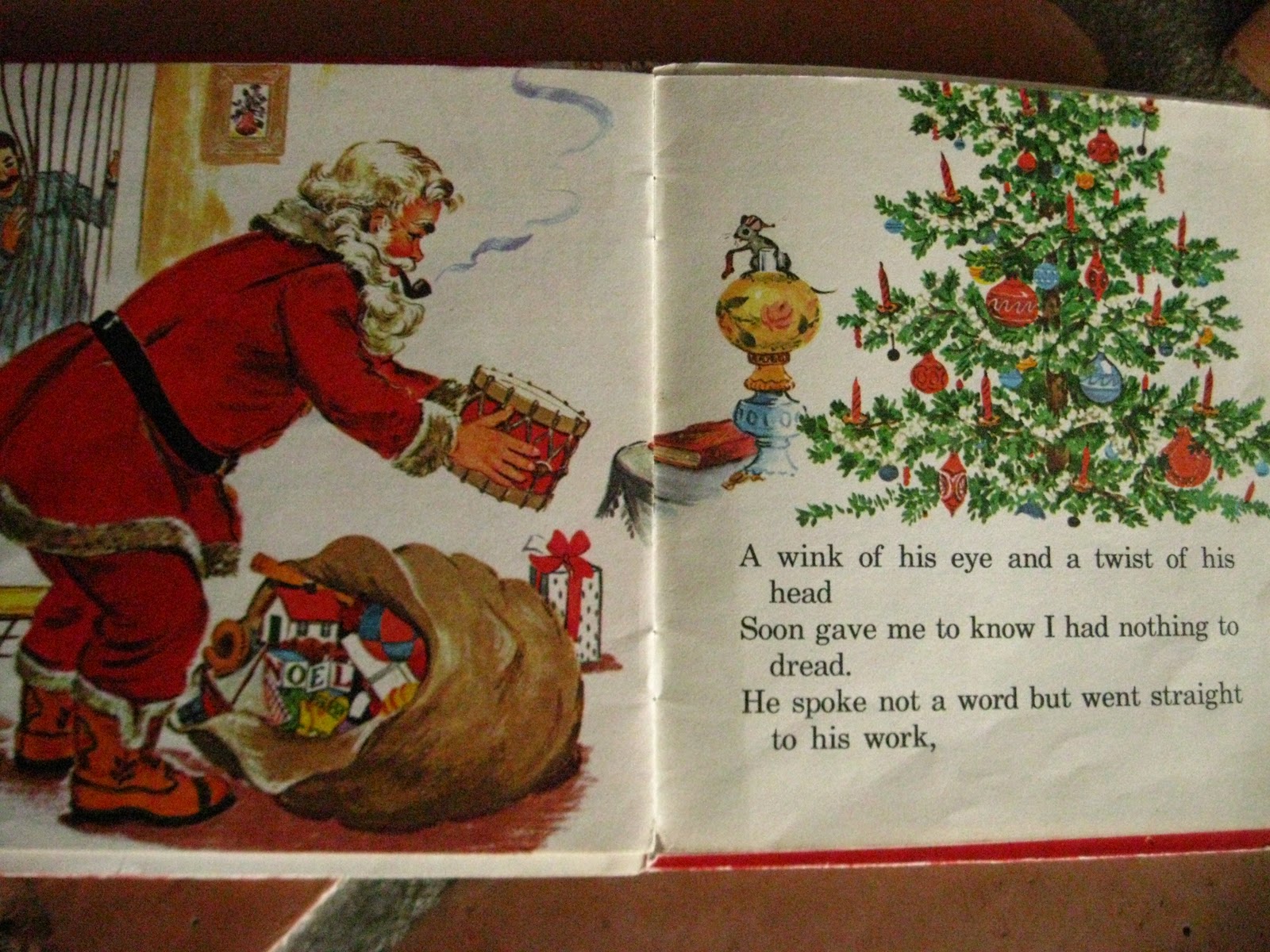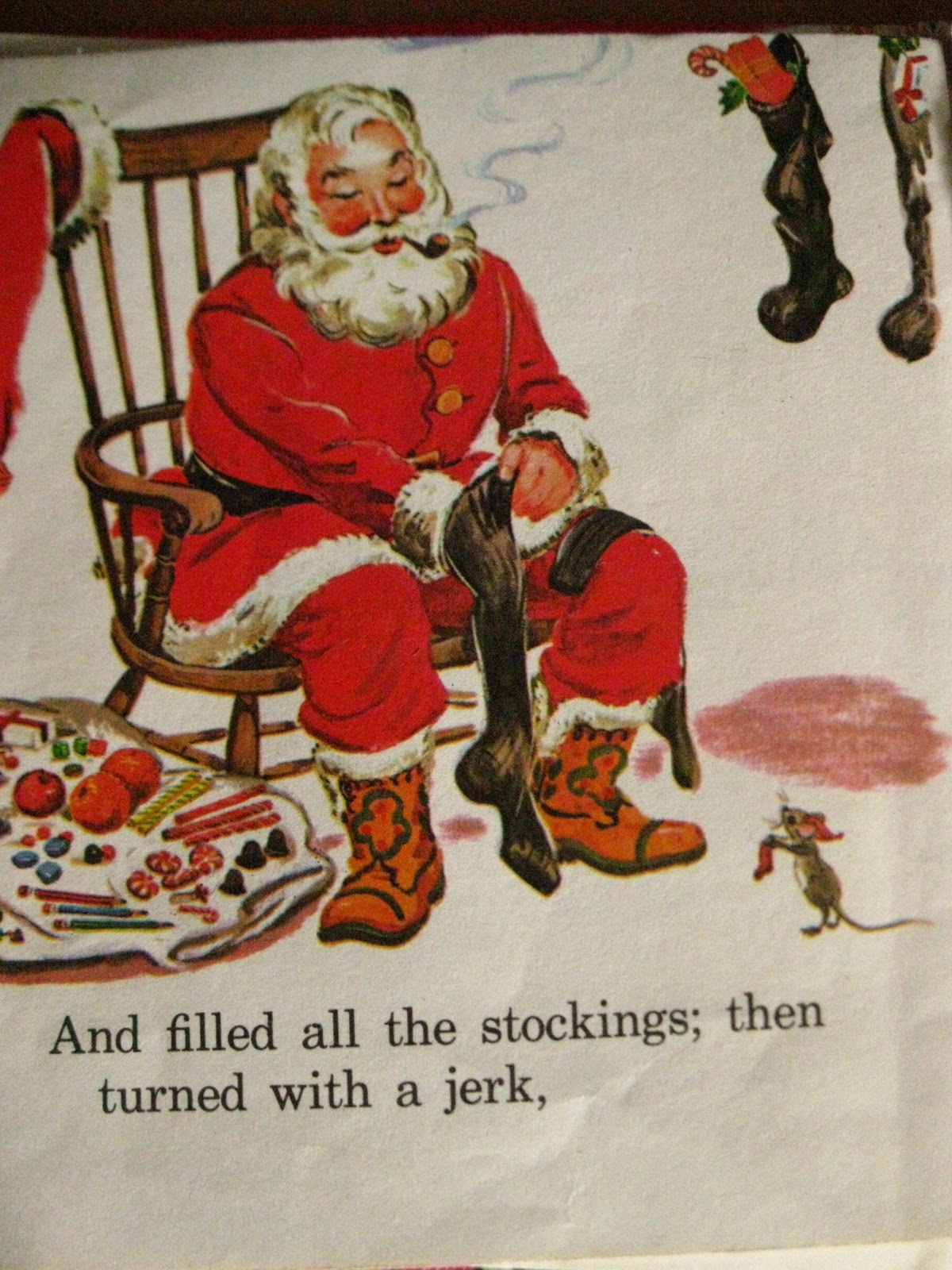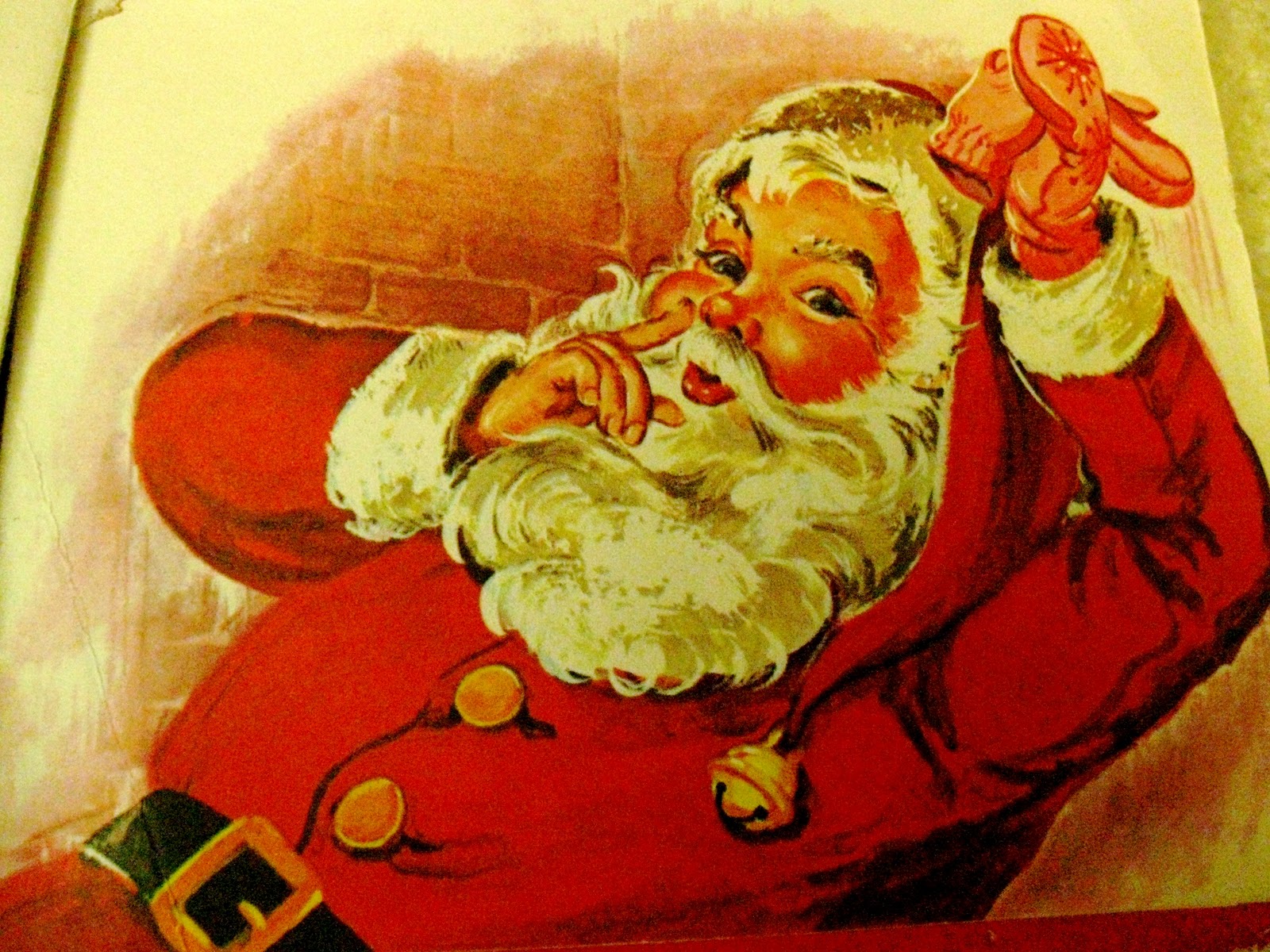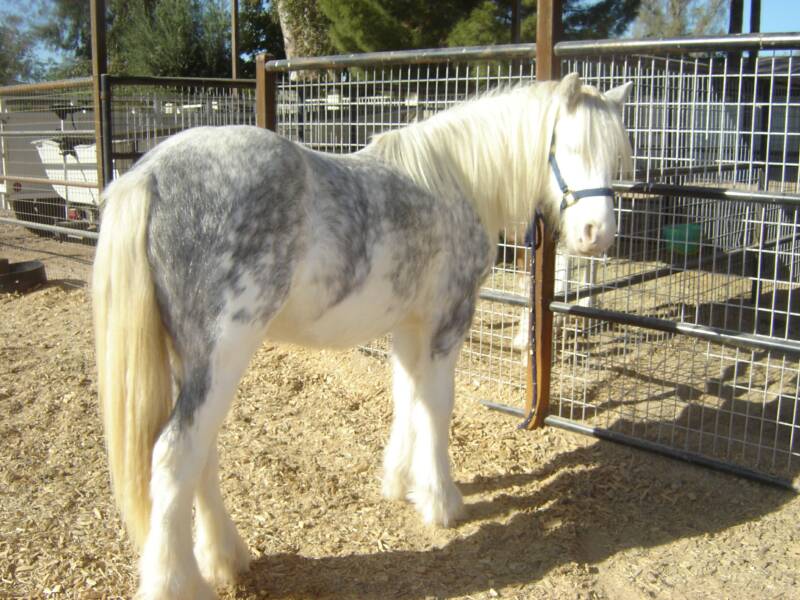My Most Favorite Book of All Time
I hope this book never gets lost or destroyed, and that someday my boys can read it to their children.Someday.Far, far in the future.
I hate those questionnaires that ask: "What's your favorite book/movie?"As if.As if I could decide on only ONE. It's like Sophie's Choice. I cannot choose! I cannot choose!But this year at Christmas it finally hit me. I've had this book since I was five:
I still write my name in the front of my books, but back then I was a bit more enthusiastic about dotting my "i"s.My mom used to buy these Whitman Tell-A-Tale books for a quarter at the grocery store, probably just to shut me up so she could get done with her shopping. Moms all over the world are familiar with this tactic, but how many great things like this can you find anymore for (published price) 29 cents?
I have taken this book out every year on Christmas Eve to read to my kids, and this year was no exception. My oldest son, 17, and my youngest, 13, still sat all the way through, and my husband listened along, too.
The illustrations were done by an artist named Florence Sarah Winship. I have a few more books featuring her artwork, and after a precursory internet search, I can't find any information on her, other than she was born in Indiana and lived in Illinois. But what great detail! I really though that sugarplums must look like This. At least they should, anyway. I looked up real sugarplums online, and they're not nearly as pretty. Not to mention there are images labeled "sugar plum" that have absolutely nothing to do with either sugar or plums....
Gray Factor in Horses
A lesson in horse color genetics from someone who only understands it a little bit:
This is a picture of Chroicoragh when she was a baby, with her dam in Ireland: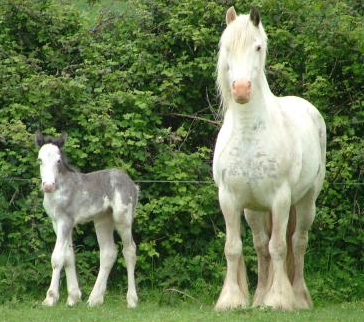
| Clononeen Farm |
Here she is a little older:
Even older:
 |
| Photo by Tami Gramont |
And today:
This is where I have to introduce you to two terms: Homozygous and Heterozygous. Homozygous is dominant. If you have a horse that is homozygous for the black gene, that horse's babies will always be black. If the horse is equally homozygous for the Tobiano gene, that horse's babies will also always be black, and spotted. So for a breeder who loves black spotted horses, having a stallion or mare that is homozygous for black tobiano is a premium. Every foal is guaranteed to be spotted and black. Likewise, if a breeder prefers Chestnuts or Palominos, they will want a horse that is homozygous for Red. There are endless possibilities when it comes to color combination, and unless you have a homozygous horse, you have no idea what the resulting foal will look like. I kind of like it that way. I like surprises.When I first saw Chroicoragh, and a picture of her mom and dad, I had no idea her color would change. As I found out more about blues and grays, I hoped she would keep her beautiful blue blanket. In western terms, her coloring would be called "Blue Sabino," in Gypsy terms, it's called Blue Blagdon. Everyone has a favorite color and pattern. Some love the splotchy pinto patterning that most Gypsy Horses carry, called Tobiano. It can come in any color, but the most common is black. Tobiano is a coat pattern that is carried genetically, as well as coloring.
 |
| Lenny is a Heterozygous Black Tobiano |
Chroicoragh carries one red gene, and one black gene, and is negative for tobiano. Which means she could have a baby that is either red (Chestnut; Sorrel) or black, and would most likely not have a baby with spots unless she was bred to a stallion who was homozygous for the tobiano gene.Following so far? OK, 'cause now I'm going to throw another one at you: Chroi is also negative for the Agouti gene, which is responsible for the black points you see on Buckskins and Bays. (A great example of the Agouti gene in bays is sweet Siofra, a bay blagdon who had a gorgeous buckskin colt, Arthur.)Chroi's color genes look like this:aa (Agouti - negative);Ee (one black, one red); andto/to (Tobiano - negative) So why is she losing her lovely blanket? The only answer, the wild card: The Gray Gene. The gray gene is responsible for most of the white horses you see. Huh? Yes, what you think is a "white" horse is technically gray. Until a few years ago, you couldn't even test for the gray gene. If you had a white or gray horse, you pretty much had a 50/50 chance of getting a gray foal, but you didn't know if it would be a 100% chance. The kicker is, a gray horse can be born any color. Well, besides purple.I had a little foggy inkling that Chroi might not be a true "Blue" horse - blue horses are technically black, with a lot of white hairs mixed in that gives them the bluish or grayish coloring, but don't necessarily carry the gray gene. These horses will remain blue their entire lives, and not fade.
So why is she losing her lovely blanket? The only answer, the wild card: The Gray Gene. The gray gene is responsible for most of the white horses you see. Huh? Yes, what you think is a "white" horse is technically gray. Until a few years ago, you couldn't even test for the gray gene. If you had a white or gray horse, you pretty much had a 50/50 chance of getting a gray foal, but you didn't know if it would be a 100% chance. The kicker is, a gray horse can be born any color. Well, besides purple.I had a little foggy inkling that Chroi might not be a true "Blue" horse - blue horses are technically black, with a lot of white hairs mixed in that gives them the bluish or grayish coloring, but don't necessarily carry the gray gene. These horses will remain blue their entire lives, and not fade.
 And when Keira was born jet black, I was so elated! Then she started showing some gray hairs in her coat, and my suspicions were confirmed. For Keira to be going gray, that means Chroi has to be gray. The question is, Homozygous, or Heterozygous? And why does it matter? Well, like I said, everyone has color preferences. Personally, grays have always been my favorite. I went to YMCA camp when I was 13, and my horse for the week was a tall dapple gray named Dapper Dan *sigh* I loved him. And if you've read my essay, you'll know my white/gray partiality has been with me a long time.But some people don't like grays. A gray horse, over time, will fade to white. And white horses have a higher chance of developing melanoma, or skin cancer. Besides, some people just don't like white. (crazy, I know! How could you not like a white horse?)
And when Keira was born jet black, I was so elated! Then she started showing some gray hairs in her coat, and my suspicions were confirmed. For Keira to be going gray, that means Chroi has to be gray. The question is, Homozygous, or Heterozygous? And why does it matter? Well, like I said, everyone has color preferences. Personally, grays have always been my favorite. I went to YMCA camp when I was 13, and my horse for the week was a tall dapple gray named Dapper Dan *sigh* I loved him. And if you've read my essay, you'll know my white/gray partiality has been with me a long time.But some people don't like grays. A gray horse, over time, will fade to white. And white horses have a higher chance of developing melanoma, or skin cancer. Besides, some people just don't like white. (crazy, I know! How could you not like a white horse?)
So I pulled a few hairs from both girls and sent them off to be tested for gray. The results (drumroll please): Both Chroicoragh and Keira are Heterozygous for the gray gene. That means that while it appears that both of them are gray, and will eventually fade to white, they only have a 50% chance of passing it on to their foals. So that's good news.Why? Well, for Chroi, since she is in foal to Lenny, and he carries the same color traits, their next baby (Keira is the first) has a possibility of being Red or Black, with a lower possibility of being spotted. Lenny is Heterozygous for Tobiano, so it's only a 25% chance. But Chroi has a red half-sister (Desert Jewel Rococco), a non-fading blue half-sister (Desert Jewel Lile), both out of Lloyds, above, and Lenny has thrown quite a few red foals. So it's anyone's guess. There's also a 50% chance that no matter what color the foal is, that it will go gray, like Keira.
 |
| Never mind the brown - that's mud :) |
The great thing about Keira going gray is that she is going to do it beautifully. Her mane and tail are already well on their way to white, and since her whole body is dark, it will dapple out in a gorgeous splash. She won't go fully white until she is well into her teens, and along the way she will look like a living, breathing Carousel horse.Keira is listed for sale. Please visit her page for details: KeiraHere is a new picture of Keira, showing her pretty dapples:
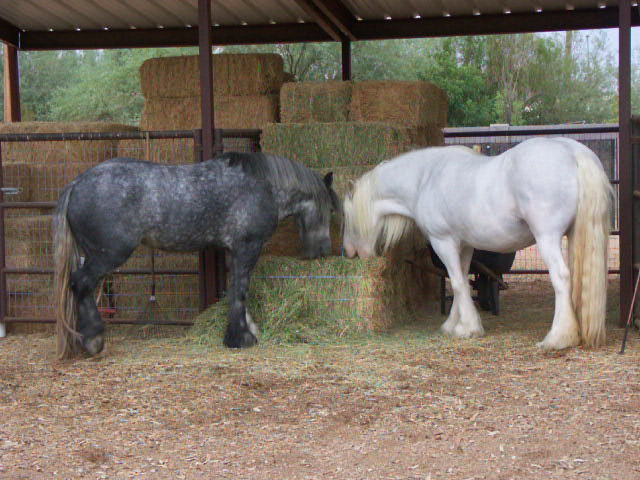 Here are some examples of Gray factor.Another helpful page on equine genetics, brought to my attention by a reader. (Thanks, Sarah!)
Here are some examples of Gray factor.Another helpful page on equine genetics, brought to my attention by a reader. (Thanks, Sarah!)
| Platinum, Vines Gypsy Horse © Michael Vine |
|
December, Dandelions.
I talk to her belly when I'm out in the stall, and try to get the baby to kick my hand
 Days are short. I go out to the barn in my pajamas, work clogs, and my husband's hunting jacket. The air is crisp and cool and my feet are cold. I'm grateful for the chill in the air. It's a welcome relief from the long hot summer. It gets so dry and dusty here that sometimes you feel coated in grime, like the layer of dust on everything in the garage has settled onto you, too. On those searing August days, I long for a place where things are damp and green and growing wild.But now that winter is near, the air conditioning is off and we drape ourselves in too-dormant sweaters, thankful for the nip in the air, however slight, and wait for the tourists to show up in their shorts and tank tops, reveling in the "warm" winter.
Days are short. I go out to the barn in my pajamas, work clogs, and my husband's hunting jacket. The air is crisp and cool and my feet are cold. I'm grateful for the chill in the air. It's a welcome relief from the long hot summer. It gets so dry and dusty here that sometimes you feel coated in grime, like the layer of dust on everything in the garage has settled onto you, too. On those searing August days, I long for a place where things are damp and green and growing wild.But now that winter is near, the air conditioning is off and we drape ourselves in too-dormant sweaters, thankful for the nip in the air, however slight, and wait for the tourists to show up in their shorts and tank tops, reveling in the "warm" winter.
Chroicoragh and Keira's hair is growing in thick and shaggy. It gives them a nice wooly plump appearance, especially Chroi, in her eighth month of gestation. I talk to her belly when I'm out in the stall, and try to get the baby to kick my hand. Not super fat yet, she is in the stage of the healthy pregnancy glow. And hungry! She chases Keira into her own stall at feeding time so they won't have to share.Most people think that an animal's coat gets thicker in winter due to the change in weather. It actually has to do with the hours of daylight. As the days get shorter, even when the weather is still warm, the winter coat starts to grow in. The length of the day is the biological sign to the horse (bear, caribou, whatever) that winter is nearing, and since it takes a while to grow all that hair, they get a jump start after the summer solstice. That's the longest day of the year. The days following get progressively shorter and shorter in hours of daylight until the winter solstice (which is the shortest day of the year).This phenomenon also effects when an animal will come into estrous. After the winter solstice, when the days start getting longer again, the mare will realize that spring is on the way (even though it's is still cold), and that the coming weather will permit the safe care of her foal -- warm air and plenty of fresh forage, packed with nutrients. So she will start to cycle, producing eggs and just waiting around for some stud to show her a good time...But back to the daylight.
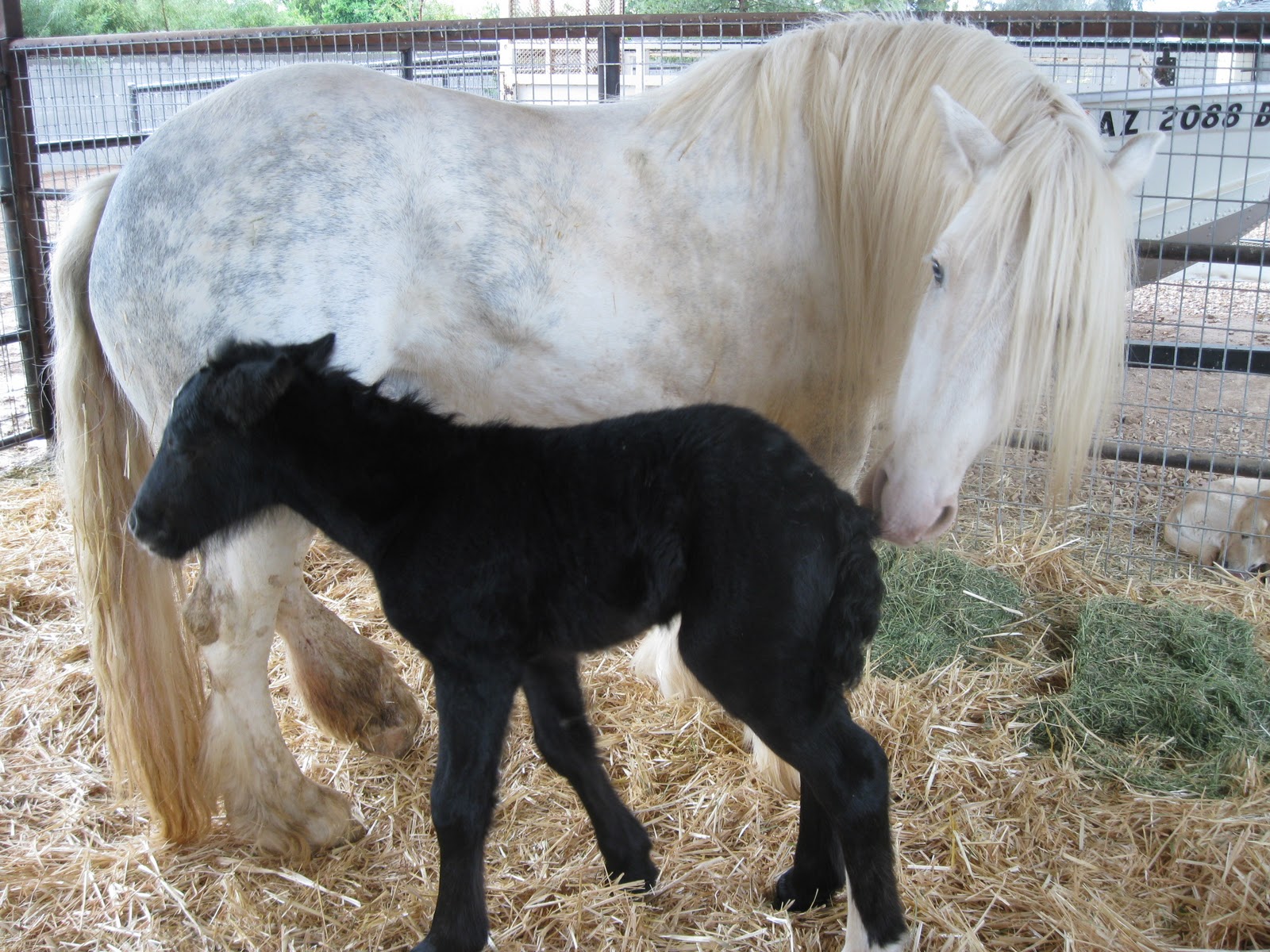 |
| Awww. New babies are so much fun! |
A practice that is well known among horse breeders and trainers, but probably unknown to most others, is the use of artificial light to manipulate the onset of estrous. The first time I planned to breed my horses, the vet said to make sure I put the mares "under lights" starting in mid-January. Keeping the horse in a stall at night with the lights on, tricks her body into thinking that the days are getting longer, and she will start her cycle. The reason for this, in our case anyway, is that a horse's natural time of year to get pregnant and have babies is in the spring, and they will be very young in the nice calm summer months.Well that's all fine and good if your summer months are mild and balmy, but in the desert our summer months are more like the inside of a kiln. We don't like our babies baked, so we tweak our breeding season to the earlier months. Putting a mare under lights in January will prompt her into becoming fertile earlier, thus foaling earlier in the year so the baby will be good and strong by the time the heat hits in June. The gestation cycle for horses is eleven months, so breeding in April gets you a foal by the next March. March is Arizona is gorgeous. (So if you are planning a trip here, and are tempted by the lower "off-season" rates in June-September, skip it. Go to Alaska in the summer. Come to AZ in the winter; you will be so glad you did.)Another reason people put their horse under lights is to keep their coat short and glossy for showing. Show horses don't want to be shaggy, so they spend the nights under lights to get fooled into thinking it's summer, and get to wear jackets to keep warm.
But if the sight of bright yellow dandelions in my yard in December is any kind of a clue, we won't have to worry too much about that. :)I think I felt a kick today.
So you Want to Write a Novel
OK, This is kind of a little mini-post while I'm working on the next real post. I just thought it was too funny not to share with you. This is from Natathan Bransford's blog, for the writers in the crowd:
See you soon.
Heidi


